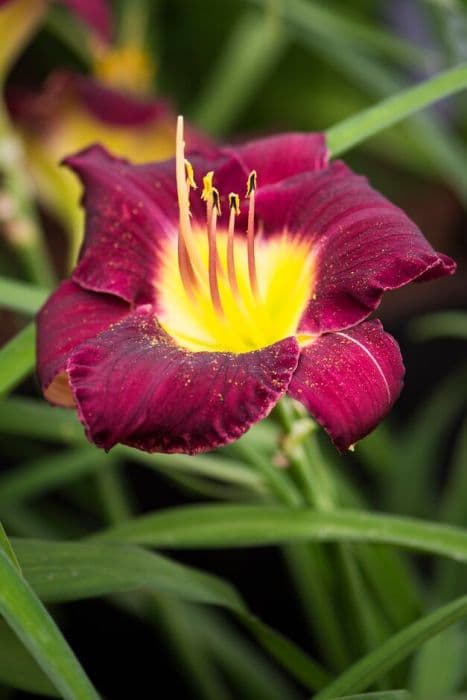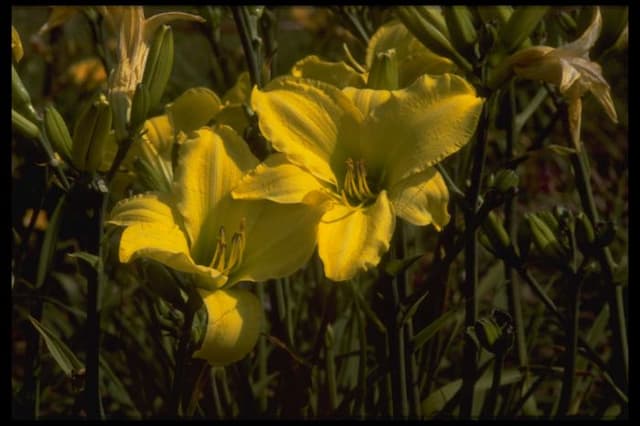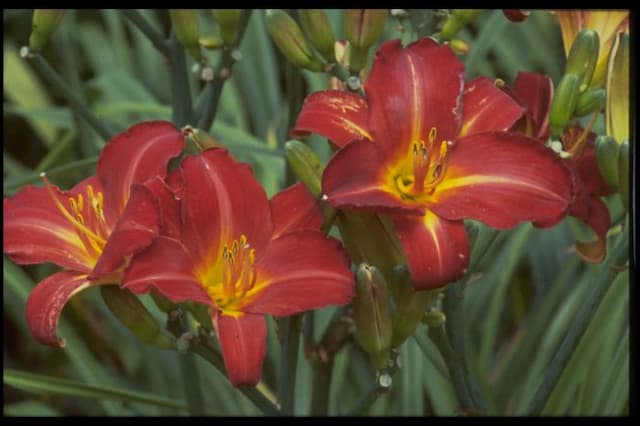Daylily Hemerocallis Golden Zebra = 'Malja' (PBR) (v)
![daylily [Golden Zebra]](/_next/image?url=https%3A%2F%2Fplants-admin.emdemapps.com%2Fimages%2Fplants%2F%2Fimages%2F604b54377e2bf.png&w=3840&q=75)
ABOUT
The 'Golden Zebra' Daylily, known by its cultivar name 'Malja', is a striking ornamental plant that features a mesmerizing combination of foliage and bloom characteristics. Its leaves are distinctive, boasting a patterned display of creamy yellow to white stripes which play dramatically against the dark green edges, giving the appearance of zebra stripes. The foliage provides a lush, grassy backdrop to its flowers. The flowers of the Golden Zebra Daylily are no less spectacular, characterized by their vivacious golden-yellow hue. Each trumpet-shaped bloom unfurls to reveal an exquisite, ruffled texture, with slightly recurved petals that add dimension and movement to the overall floral display. The blossoms can be quite large and eye-catching, typically presenting with a singular darker eyezone at the base of the petals that serves to accentuate their sunny color. With these dramatic blooms atop the contrasting variegated foliage, the Golden Zebra Daylily stands as a captivating and vibrant addition to any garden, offering a bold splash of color and an intriguing play of patterns that can attract both casual admirers and dedicated horticulturists alike.
About this plant
 Names
NamesFamily
Hemerocallidaceae.
Synonyms
Golden Zebra Daylily, Striped Daylily, Variegated Daylily.
Common names
Hemerocallis 'Malja'
 Characteristics
CharacteristicsLife cycle
Perennials
Foliage type
Deciduous
Color of leaves
Variegated
Flower color
Yellow
Height
2 feet (60 cm)
Spread
2 feet (60 cm)
Plant type
Bulb
Hardiness zones
Varies
Native area
Asia
Benefits
 General Benefits
General Benefits- Attractive Foliage: Hemerocallis Golden Zebra, commonly known as the Daylily, features striking variegated foliage that adds visual interest to any garden.
- Colorful Blooms: The plant produces vibrant yellow flowers that can enhance the beauty of garden beds and borders.
- Drought Tolerance: Daylilies are known for their ability to withstand periods of drought once established, making them suitable for low-water gardens.
- Low Maintenance: They require minimal care beyond basic watering and occasional fertilizing, making them a good choice for busy gardeners.
- Pest Resistant: Daylilies are resistant to many pests and diseases, reducing the need for chemical treatments.
- Adaptable to Various Soils: They can thrive in a wide range of soil conditions, from sandy to clay, as long as the soil is well-drained.
- Attracts Pollinators: The flowers of the Daylily attract bees, butterflies, and other beneficial pollinators to the garden.
- Erosion Control: Their root system can help stabilize soil and prevent erosion on slopes or in problematic areas.
- Edible Parts: Some parts of daylilies are edible and are used in culinary dishes, adding an extra functionality to the plant.
- Long Blooming Period: Daylilies typically have a lengthy blooming season, providing long-lasting color in the landscape.
 Medical Properties
Medical PropertiesThis plant is not used for medical purposes.
 Air-purifying Qualities
Air-purifying QualitiesThis plant is not specifically known for air purifying qualities.
 Other Uses
Other Uses- The dried flower petals of the daylily can be used as a natural dye for fabrics, offering a range of colors from yellows to oranges, depending on the mordant used.
- Daylilies can be added to compost heaps as they decompose well and add nutrients back into the soil, helping to create a rich compost for gardening.
- The sturdy foliage of daylilies can provide support for weaker plants in the garden, as neighboring plants can lean on them without causing damage to the daylily.
- Daylily flowers can be used in floral arrangements, both fresh and dried, as their vibrant colors and interesting patterns can add to the aesthetic of bouquets and crafts.
- The tuberous roots of daylilies can be divided and shared with friends or fellow gardeners to propagate and spread the joy of gardening within the community.
- Daylily flower buds can be pickled, providing a unique tangy addition to salads or as a garnish for various dishes.
- As an artistic inspiration, the striking look of daylilies can be a muse for botanical illustrations, photography, or paintings, capturing their beauty in various art forms.
- In fish ponds or water features, daylily plants can be used around the edges to provide shade and shelter for aquatic life, and to enhance the natural look of the water garden.
- During transplanting, daylily's root system can help to bind the soil and prevent erosion, especially in sloped areas of the garden where soil retention is crucial.
- Culinary artists can use daylily flowers as part of edible table decorations, adding a touch of elegance and creativity to their food presentation.
Interesting Facts
 Feng Shui
Feng ShuiThe Daylily 'Golden Zebra' is not specifically used in Feng Shui practice.
 Zodiac Sign Compitability
Zodiac Sign CompitabilityThe Daylily 'Golden Zebra' is not used in astrology practice.
 Plant Symbolism
Plant Symbolism- Perseverance and resilience: As a type of daylily, Hemerocallis 'Golden Zebra' symbolizes perseverance due to the plant's hardy nature and ability to thrive in various conditions.
- Beauty and Pride: The striking appearance of the 'Golden Zebra' daylily, with its bold stripes and contrast, represents beauty and pride in one's unique characteristics.
- Fleeting nature of life: Each flower of the Hemerocallis lasts only for a day, reminding us of the transient nature of life and the importance of cherishing each moment.
- Motherhood: In Chinese culture, daylilies are associated with motherhood and the devotion of mothers, due to the plant's nurturing ability to produce new flowers daily.
- Renewal and new beginnings: The constant blooming of new flowers on the daylily plant embodies the concept of renewal and the fresh start each new day brings.
 Water
WaterDaylilies, like the Hemerocallis Golden Zebra, require consistent moisture, especially during the growing season. They should be watered deeply once a week, providing about an inch of water which equates to approximately 0.623 gallons per square yard. During hot, dry periods, additional watering may be necessary to maintain soil moisture. Water the plants at the base to avoid wetting the foliage, which can promote fungal diseases. During the winter or in dormant periods, reduce watering as the plant's water requirements decrease.
 Light
LightDaylilies, including the Hemerocallis Golden Zebra, thrive in full sunlight to light shade. They perform best when receiving at least six hours of direct sunlight daily. An ideal spot would be a sunny border or an open area that is well-lit for the majority of the day. If planted in too much shade, the plant may produce fewer flowers and have a less vigorous growth.
 Temperature
TemperatureDaylilies such as the Hemerocallis Golden Zebra are hardy and can tolerate a range of temperatures, from well below freezing to very warm conditions. They can survive minimum temperatures down to around -20°F and are comfortable in summer temperatures up to 90°F. The ideal temperature for vigorous growth and flowering is between 60°F and 75°F.
 Pruning
PruningPruning the Hemerocallis Golden Zebra, commonly known as daylily, encourages reblooming and maintains plant health. Remove spent flower stalks to redirect the plant's energy into producing more blooms. After flowering, prune back dead foliage in late fall to keep the plant tidy and reduce the likelihood of disease. Pruning is typically done annually, or as needed when the plant appears unkempt.
 Cleaning
CleaningAs needed
 Soil
SoilThe Daylily 'Golden Zebra' thrives in well-draining soil rich in organic matter with a pH of 6 to 6.5. A mix of garden soil, compost, and a little sand or perlite is ideal. Regularly enriching the soil with compost will support its growth.
 Repotting
RepottingDaylilies like 'Golden Zebra' rarely need repotting as they are usually grown outdoors. If grown in containers, repot only when overcrowded, typically every 3 to 4 years.
 Humidity & Misting
Humidity & MistingDaylily 'Golden Zebra' is tolerant of a wide range of humidity levels and does not have specific humidity requirements, making it adaptable to various outdoor conditions.
 Suitable locations
Suitable locationsIndoor
Ensure bright indirect light, adequate watering, and good air circulation.
Outdoor
Plant in full sun to partial shade in fertile, well-drained soil.
Hardiness zone
3-9 USDA
 Life cycle
Life cycleThe Daylily 'Golden Zebra', scientifically known as Hemerocallis 'Malja', first begins its life as a seed, which will germinate under appropriate conditions of warmth and moisture. Once germination occurs, the seedling emerges and establishes a small clump of strap-like foliage, bearing distinct creamy-yellow and green variegated leaves. The plant enters a vegetative stage where it grows and multiplies through underground roots known as rhizomes, forming a larger clump. After a period of vegetative growth, often a year or more, the Daylily 'Golden Zebra' reaches maturity and produces tall, robust stalks topped with buds that will open into large, striking blooms, usually in early to mid-summer. Each individual flower lasts only one day, hence the common name "Daylily," but the plant will produce many buds, providing a prolonged flowering period. As the blooming season ends, the plant will enter a period of dormancy, especially in colder climates, wherein the foliage dies back, and the plant conserves energy in its rhizomes to survive the winter and rejuvenate in the spring.
 Propogation
PropogationPropogation time
Early Spring
The most popular method of propagating the Hemerocallis Golden Zebra, also known as the daylily, is through division. This is best done in the early spring or fall when the plant is not in active bloom. To propagate by division, carefully dig around the daylily clump and lift it from the soil, minimizing root damage. Gently shake or rinse off excess soil so that you can see the individual fans of leaves with their associated roots. Using a sharp knife or spade, divide the clump into smaller sections, making sure each section has at least one fan of leaves and a portion of the root system. Replant the divisions at the same depth they were growing before, spacing them about 12 to 18 inches (30 to 45 centimeters) apart to give each new plant enough space to grow. Water the new divisions thoroughly to help them establish in their new location.









